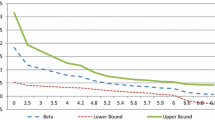Abstract
This paper examines the impact of intellectual property rights (IPR) infringement on the input (R&D spending) and output (patents) of the research process. The extant literature proxies IPR enforcement via composite indices or indicators of institutional quality, whereas this paper employs a direct (hard) measure of IPR crimes. Using data across U.S. states, results show that IPR crimes reduce research spending but do not impact patenting. Upon comparison with a broader measure of weak institutional quality (corruption), we find that greater corruption has a robust negative effect on patenting, but not on R&D spending. Quantitatively, the elasticities of R&D spending with respect to IPR crimes are greater than those of patents with respect to corruption, suggesting that studies that proxy IPR crimes via other measures are likely underestimating their impacts on technological change.
Similar content being viewed by others
Notes
Examples of related institutions are those dealing with governance, economic freedom and IPR protection (see Krammer 2015).
Along another related dimension, corruption and rent-seeking might impact the scope of patents (Goel 2002).
In light of the well-known multidimensional nature of corruption, one could argue that R&D and patents could have reverse feedbacks on corruption. This seems less likely with the state-dependent nature of most R&D. Further, the cross-sectional nature of our data mitigates these concerns (which could be examined with appropriate data in due course). Also see Sect. 4.5.
The insignificance of state size can partly be understood in the context of information leakages or spillovers via the internet, since such spillovers are less constrained by physical borders or state size.
There is more than one way to conduct mediation analysis. Our analysis was conducted using the “sem” command in STATA (for details, see https://stats.idre.ucla.edu/stata/faq/how-can-i-do-mediation-analysis-with-the-sem-command/).
For example, the direct effect of corruption would be (∂PATENT/∂CORRUPT), and the indirect effect would be (∂PATENT/∂TotalR&D)(∂TotalR&D/∂CORRUPT), and likewise for the case of IPRcrime.
This insignificance of IPRcrime is in line with the lack of significance in related correlations in Table 2.
References
Besen, S. M., & Raskind, L. J. (1991). An introduction to the law and economics of intellectual property. Journal of Economic Perspectives,5(1), 3–27.
Coe, D. T., & Helpman, E. (1995). International R&D spillovers. European Economic Review,39(5), 859–887.
Coe, D. T., Helpman, E., & Hoffmaister, A. W. (2009). International R&D spillovers and institutions. European Economic Review,53(7), 723–741.
Cohen, W. M., Goto, A., Nagata, A., Nelson, R. R., & Walsh, J. P. (2002). R&D spillovers, patents and the incentives to innovate in Japan and the United States. Research Policy,31(8–9), 1349–1367.
d’Aspremont, C., & Jacquemin, A. (1988). Cooperative and noncooperative R&D in duopoly with spillovers. American Economic Review,78(5), 1133–1137.
Denicolò, V., & Franzoni, L. A. (2012). Weak intellectual property rights, research spillovers, and the incentive to innovate. American Law and Economics Review,14(1), 111–140.
Dimant, E., & Tosato, G. (2018). Causes and effects of corruption: What has past decade’s empirical research taught us? A survey. Journal of Economic Surveys,32(2), 335–356.
Feldman, M. P. (1999). The new economics of innovation, spillovers and agglomeration: A review of empirical studies. Economics of Innovation and New Technology,8(1–2), 5–25.
Goel, R. K. (1999). Economic models of technological change. Westport, CT: Quorum Books.
Goel, R. K. (2002). Uncertain patent scope and R&D investment. Economia Internazionale/International Economics, 55(1), 17–24.
Goel, R. K. (2003). Rent-seeking in research markets. Journal of Technology Transfer,28(2), 103–109.
Goel, R. K., & Saunoris, J. W. (2016). Institutional path dependence and international research intensity. Economic Modelling,52(PB), 851–858.
Goel, R. K., Saunoris, J. W., & Zhang, X. (2016). Intranational and international knowledge flows: Effects on the formal and informal sectors. Contemporary Economic Policy,34(2), 297–311.
Griliches, Z. (1992). The search for R&D spillovers. Scandinavian Journal of Economics,94(supplement), S29–S47.
Krammer, S. M. S. (2014). Assessing the relative importance of multiple channels for embodied and disembodied technological spillovers. Technological Forecasting and Social Change,81, 272–286.
Krammer, S. M. S. (2015). Do good institutions enhance the effect of technological spillovers on productivity? Comparative evidence from developed and transition economies. Technological Forecasting and Social Change,94, 133–154.
Lerner, J. (2002). 150 years of patent protection. American Economic Review,92(2), 221–225.
Mohnen, P. (2009). Introduction and overview of the symposium issue: Innovations and intellectual property values. Journal of Technology Transfer,34(2), 121–127.
Park, W. G. (2008). International patent protection: 1960–2005. Research Policy,37(4), 761–766.
Acknowledgements
I would like to thank Al Link and German Blanco for useful insights.
Author information
Authors and Affiliations
Corresponding author
Rights and permissions
About this article
Cite this article
Goel, R.K. IPR infringement in the United States: impacts on the input and output of R&D. J Technol Transf 45, 481–493 (2020). https://doi.org/10.1007/s10961-018-9708-y
Published:
Issue Date:
DOI: https://doi.org/10.1007/s10961-018-9708-y



